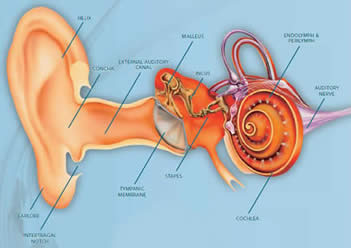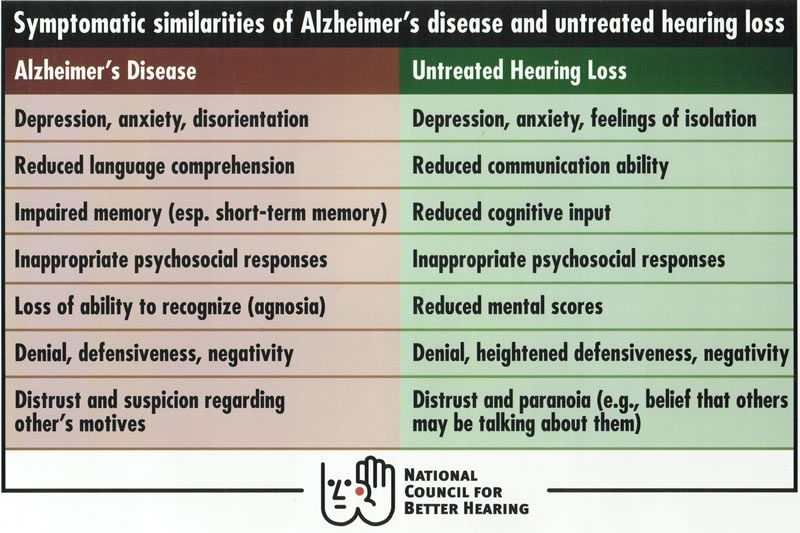Midwest Ear, Nose & Throat strives to provide information and education to patients who deal with a hearing loss, whether it be their own or that of a loved one. Becoming informed about hearing loss is the first step to conquering it. Below we provide some frequently asked questions and answers about hearing loss.
Hearing
How do we hear?
The human ear is an intricate and delicately balanced structure of the body. In order to understand hearing loss, it is important to know how a normally functioning ear works.
The ear is divided into three parts: outer ear, middle ear and inner ear.

The outer ear includes the visible portion of the ear, called the auricle or pinna, and the ear canal. The pinna is made of cartilage and skin and is formed in the shape of a funnel in order to help gather sound from the environment. This helps in determining the direction of the source of the sound and directing sound down into the ear canal. Sound then travels down the ear canal and into the middle ear.
Middle Ear
The eardrum (tympanic membrane) is a very thin piece of skin that vibrates when sound reaches the membrane. The eardrum acts as the entrance to the air-filled middle ear cavity. Within the middle ear cavity there are three small bones – the malleus (hammer), incus (anvil), and stapes (stirrup). These three small bones move back and forth, transferring sound waves into the fluid-filled cavities of the inner ear. Because the middle ear is filled with air, the air pressure must be equalized to the environmental air pressure by the Eustachian tube, which connects the middle ear with the back of the throat and nose. This is where a hearing aid would be placed.
Inner Ear
The inner ear consists of both the hearing and balance organs. The hearing organ, called the cochlea, is filled with thousands of sensory hair cells that send neural impulses via the VIII (8th/auditory) nerve to the part of the brain responsible for understanding. These hair cells are pitch/frequency specific and allow the human ear to hear various loudness levels and pitches of sounds. The semi-circular canals – the organs of balance – are also located within the inner ear.
For more information about our services, call 888-336-3503 or 605-275-1205.
What are the signs and symptoms of hearing loss?
People don’t usually even notice they have a hearing loss because it is not physically painful or visible, and happens gradually. Here is a list of some symptoms to watch for.
- You often ask others to repeat themselves.
- It is particularly difficult to understand conversations when there is background noise.
- You can hear everything; you just can’t understand it anymore.
- It often seems as though others are mumbling when they speak to you.
- You have to pay attention to people’s lip movements and expressions to understand what they are saying.
- You feel frustrated trying to communicate in group situations.
- You have trouble hearing children and women.
- You turn up the TV or radio louder than others prefer.
- You are beginning to limit or modify your social activities.
- You find it difficult to identify which direction sounds are coming from.
All these symptoms can be helped by hearing aids.
For more information about our services, call 888-336-3503 or 605-275-1205.
What are the most common hazards for hearing?
Excessive noise at work
Noise levels should not exceed 85 decibels. OSHA requires hearing protection for 90 decibels and above.
 Tractor idling, conveyors, elevators. 80dB
Tractor idling, conveyors, elevators. 80dB- Heavy truck 80-90dB
- Blower, compressor, combine 90dB
- Pig squeal, power tools. 100dB
- Crane 102dB
- Helicopter 105dB
- Bulldozer 107dB
- Airplane on the runway 110dB
- Ambulance Siren 112-120dB
- Tractor at full load, propeller aircraft, sandblasting 120dB
- Police car siren, fire truck siren 123dB
- Jet engine up close 160dB
Being around noise that causes hearing loss may result in a future need of a hearing aid
Loud Home Electronics
 People often play music through their headphones too loud. Sound systems in automobiles are also often played too loud because theyre competing with engine and traffic noise, which can dangerously increase the volume of noise to which you’re exposing your ears.
People often play music through their headphones too loud. Sound systems in automobiles are also often played too loud because theyre competing with engine and traffic noise, which can dangerously increase the volume of noise to which you’re exposing your ears.
- Typical home stereo listening level 80dB
- Stereo headphones 100dB
Damage to your ears may cause permanent loss and one may need a hearing aid
Hunting
 Gunshot/shotgun blast 140dB
Gunshot/shotgun blast 140dB- .30 caliber rifle 155dB
This may cause hearing loss in which a hearing aid may be necessary
Recreation
 Personal watercraft 85-102dB
Personal watercraft 85-102dB- Dirt bike 94dB
- F11 motorcycle 95dB
- ATV 96-100dB
- Snowmobile 110dB
- Stock car races 130dB
Concerts and Clubs/Discos
 Club/bar 118-130dB
Club/bar 118-130dB- Rock concert 120dB
Loud Tools and Machinery
 Lawn mower 90dB
Lawn mower 90dB- Power saw 95dB
- Circular saw, hammering 96dB
- Chain saw, electric drill 100dB
- Jack hammer 105 dB
- Leaf blower 106-115dB
- Power tools 110dB
Foreign Bodies in the Ear
 Never insert cotton swabs deep into the ear canal – the damage they cause far outweighs the benefits. Cotton swabs often do not remove ear wax but instead push it deep into the ear canal right in front of the ear drum. This increases the risk of an ear infection, especially for children. Another side-effect of cotton swabs can be an increase in the production of ear wax. The same applies to handkerchiefs, corners of towels, fingers, etc. Instead, clean your ears carefully with water when taking a shower, or purchase a product specifically made to clean safely clean ears.
Never insert cotton swabs deep into the ear canal – the damage they cause far outweighs the benefits. Cotton swabs often do not remove ear wax but instead push it deep into the ear canal right in front of the ear drum. This increases the risk of an ear infection, especially for children. Another side-effect of cotton swabs can be an increase in the production of ear wax. The same applies to handkerchiefs, corners of towels, fingers, etc. Instead, clean your ears carefully with water when taking a shower, or purchase a product specifically made to clean safely clean ears.
Disease and Infection
Ear infections are usually bacterial in origin, and occur mostly in children. Great care should be taken in these cases, and there should be no delay in seeking treatment. Even washing with impure water can trigger an ear infection, and this can lead to a loss of hearing.
For more information about our services, call 888-336-3503 or 605-275-1205.
How can I prevent hearing loss?
99% of noise-induced hearing loss is preventable!
- Always wear hearing protection and take breaks from noisy situations.
- Turn down the volume when listening to music.
- Never stand directly next to a loud speaker!
- Quit smoking: It doubles the risk of noise-induced hearing loss. “After a loud show, the way you get better is through blood supply to your inner-ear nerve cells,” says Chicago audiologist Michael Santucci. “If you do something cardiovascularly restrictive, like smoking, your blood supply won’t be as good. You’re being exposed to two toxins, the cardiovascular toxin and the noise toxin.”
- Add carpet and wall coverings to help reduce noise pollution in rooms.
If you already have a hearing loss you can slow down progression with hearing aids for appropriate stimulation and processing.
For more information about our services, call 888-336-3503 or 605-275-1205.
What other issues can hearing loss cause?
Untreated hearing loss significantly reduces the quality of life for those affected, especially socially and/or psychologically. In 1999, the US National Council on Aging (NCOA) conducted a study of people over 50 with hearing loss, and this survey can still be cited as representative of many other studies. The study showed that people with hearing loss who did not use a hearing instrument were more likely to suffer from depression, anxiety and agitation than those who did. They cut down on their social activities, became less emotionally stable, and had difficulty concentrating. In contrast, the study revealed that the quality of life of most hearing device users had improved substantially since they had started wearing hearing devices. Their family relationships were better, their self-esteem improved, and they felt that they had greater independence and security.
Failure to treat hearing loss without a hearing aid can lead to physical problems: In addition to a general feeling of malaise, those surveyed showed symptoms such as fatigue or exhaustion, headaches and muscular pains, dizziness, stress and high blood pressure, eating and sleep disorders, and digestive problems.

For more information about our services, call 888-336-3503 or 605-275-1205.
How to help if a loved one has hearing loss?
- Be patient
- Speak normally – not too loudly or quickly – and annunciate your words clearly.
- Be sure you have the person’s attention before you begin to speak. It is difficult for people with a hearing loss to hear or lip-read if they are not looking at the speaker.
- Encourage them to get their hearing tested
- If you are part of the decision-making process for purchasing a hearing aid make sure you speak with the specialist and understand fully what it is your loved one needs.
- Dont be afraid to ask questions when meeting with the specialist.
For more information about our services, call 888-336-3503 or 605-275-1205.
What is included in your free hearing evaluation?
A complete hearing evaluation includes an examination of your ear canal and ear drum, an assessment of how you hear tones of different pitches, and how you hear speech at different loudness levels. Click Here to see a full detailed description of all the tests ran during an evaluation.
For more information about our services, call 888-336-3503 or 605-275-1205.
